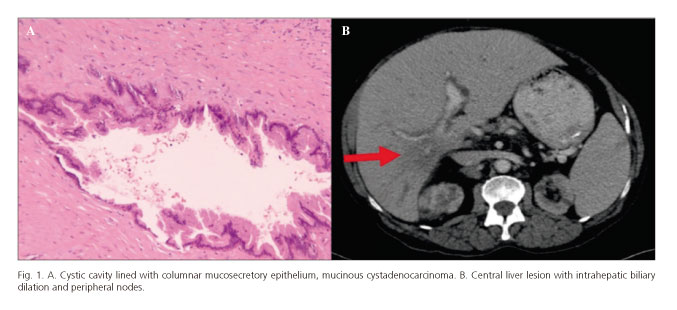My SciELO
Services on Demand
Journal
Article
Indicators
-
 Cited by SciELO
Cited by SciELO -
 Access statistics
Access statistics
Related links
-
 Cited by Google
Cited by Google -
 Similars in
SciELO
Similars in
SciELO -
 Similars in Google
Similars in Google
Share
Revista Española de Enfermedades Digestivas
Print version ISSN 1130-0108
Rev. esp. enferm. dig. vol.109 n.9 Madrid Sep. 2017
https://dx.doi.org/10.17235/reed.2017.4979/2017
LETTERS TO THE EDITOR
Sternal cutaneous metastasis of hilar cholangiocarcinoma
Metástasis cutánea esternal de colangiocarcinoma hiliar
Key words: Cholangiocarcinoma. Skin neoplasms. Differential diagnosis.
Palabras clave: Colangiocarcinoma. Metástasis cutáneas. Diagnóstico diferencial.
Dear Editor,
Cutaneous metastases occur in 2-10% of visceral tumors (1,2) and represent up to 2% of all skin tumors (2). They may be identified before their original primary tumor in an advanced stage with a poor prognosis.
Case report
We report the case of a 72-year-old female patient with severe heart failure, pulmonary hypertension and chronic renal impairment. She presented with a non-painful, erythematous, hard, 2 cm subcutaneous growth in the sternal region. The lesion was excised and the pathology analysis described a tissue layout consistent with subcutaneous metastasis of a mucinous cystadenocarcinoma that originated in the bile duct (Fig. 1A). Abdominal computed tomography (CT) showed a central liver lesion compatible with hilar cholangiocarcinoma or a Klatskin tumor (Fig. 1B). In view of the patient's baseline status, palliative care was initiated.
Discussion
Cholangiocarcinoma usually metastasizes to retroperitoneal nodes, the peritoneum, liver and lungs (1). Twenty cases of skin metastasis have been reported, most of them by direct extension following percutaneous puncturing (50%) (2,3) that were described as papules at the puncture site (4).
The mean age at presentation is 60 years (3) and the most typical lesion is a non-painful, erythematous, occasionally ulcerated nodule or papule (4). The scalp is the most commonly reported site (3).
The pathophysiology of these rare skin metastases of cholangiocarcinoma is unknown. This may be related to their poor prognosis (5-year overall survival below 5% [5]), their non-painful nature or their common location in unexposed areas of the skin.
Antonio José Fernández-López1, María Encarnación Tamayo-Rodríguez1,2 and María Ángeles Paniza-Mendoza1
1Department of General Surgery. Hospital General Universitario Reina Sofía. Murcia, Spain.
2Department of Surgery. Universidad de Murcia. Murcia, Spain
References
1. Lee WJ, Kim MS, Chang SE, et al. Multiple cutaneous metastases from hiliar cholangiocarcinoma. Cli Exp Dermatol 2009;34(5):174-6. DOI: 10.1111/j.1365-2230.2008.03022.x. [ Links ]
2. Landaluce Olavaria A, Estraviz Mateos B, Sarabia García S. Cutaneous metastasis in a patient with cholangiocarcinoma. Rev Esp Enferm Dig 2007;99(2):118-9. [ Links ]
3. Liu M, Liu B-L, Liu B, et al. Cutaneous metastasis of cholangiocarcinoma. World J Gastroenterol 2015;21(10):3066-71. DOI: 10.3748/wjg.v21.i10.3066. [ Links ]
4. Lu CI, Wong WR, Hong HS. Distant cutaneous metastases of cholangiocarcinoma: Report of two cases of a previously unreported condition. J Am Acad Dermatol 2004;51(2):108-11. DOI: 10.1016/j.jaad.2004.01.042. [ Links ]
5. Yanagi T, Marsumura T, Yoshizaki N. Cholangiocarcinoma with skin metastases. J Am Acad Dermatol 2007;56(2):S58-60. DOI: 10.1016/j.jaad.2006.02.057. [ Links ]











 text in
text in 


